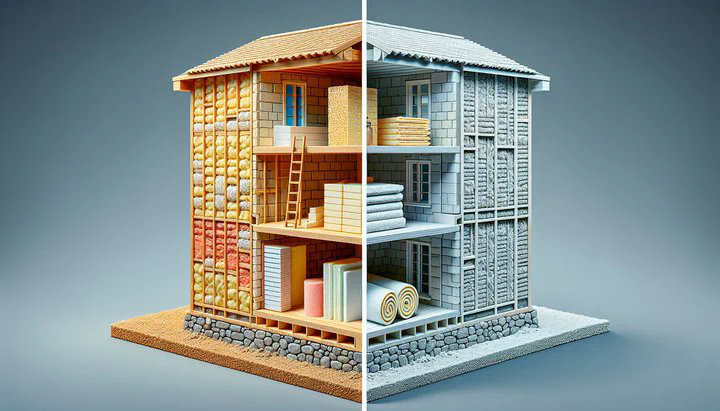Rigid vs. Batt Insulation- Understanding the Differences and Choosing the Right Type for Your Home

Rigid vs. Batt Insulation: Understanding the Differences and Choosing the Right Type for Your Home
Are you feeling a draft in your home or noticing rising energy bills? You might be considering insulation solutions but are unsure where to start. The Rigid vs. Batt Insulation question is a common one for homeowners and DIY enthusiasts. Choosing the right insulation can make your home more comfortable and energy-efficient. In this guide, we’ll explore the differences between rigid and batt insulation, so you can make the best decision for your home.
Introduction to Rigid and Batt Insulation
Insulation is like your home’s sweater, keeping it warm in the winter and cool in the summer. But which type should you choose? Rigid insulation and batt insulation are two popular options, each with unique properties.
Rigid insulation is made of strong panels, often from materials like polystyrene. It’s great for keeping temperatures steady and acts as a barrier against moisture. You’ll often see it in places like roofs and foundations.
Batt insulation, on the other hand, is made from fluffy materials like fiberglass. It’s easy to install between walls and ceilings. While affordable and flexible, it can lead to issues like batt insulation trapping moisture if not installed correctly.
Let’s dive deeper into the Rigid vs. Batt Insulation debate to help you determine the best fit for your home.
Comparing Rigid and Batt Insulation
Understanding the Rigid vs. Batt Insulation question involves looking at their materials, effectiveness, and installation process.
Material Composition and R-Value
-
Rigid Insulation: Made from solid foam panels, like polystyrene, it boasts a high R-value—a measure of insulation’s ability to resist heat flow.
-
Batt Insulation: Composed of fibers like fiberglass, it comes in rolls. Its R-value might be lower but is still effective for residential spaces.
Installation Process
-
Rigid Insulation: Requires precise cutting and sealing the seams to prevent air leaks and maximize its role as a moisture barrier.
-
Batt Insulation: Easier to fit into spaces but must be snug to avoid batt insulation trapping moisture.
Applications
-
Rigid Insulation: Ideal for basements and exterior walls, especially where moisture control is crucial.
-
Batt Insulation: Suited for attics and interior walls where ease of installation is key.
How Does Moisture Affect Rigid and Batt Insulation?
Moisture can be a big enemy of insulation. Let’s see how rigid vs. batt insulation handle it.
Rigid Insulation: A Moisture Barrier
Thanks to its materials, rigid insulation acts as a moisture barrier, keeping dampness at bay. This makes it perfect for places like basements.
Batt Insulation: Beware of Moisture Trapping
If not installed right, batt insulation can absorb moisture. This might lead to mold or dampness issues, making proper installation crucial.
Tips for Effective Moisture Control
- For Rigid Insulation: Remember to seal the seams well.
- For Batt Insulation: Use a vapor barrier and ensure a snug fit to prevent moisture buildup.
Installation Tips and Considerations
Ready to tackle your insulation project? Here’s how to install both types confidently.
Installing Rigid Insulation
- Measure and Cut: Ensure panels fit snugly.
- Secure and Seal: Use adhesives and seal the seams to prevent air leaks.
Installing Batt Insulation
- Protect Yourself: Wear gloves and masks.
- Cut to Fit: Ensure a snug, gap-free fit.
Community Insights
One HomeSolver community member found that using a broom handle to push batt insulation into tight spots helps achieve a snug fit without compressing it.
Choosing the Right Insulation for Your Home
Confronted with the Rigid vs. Batt Insulation question, consider these factors:
Climate Considerations
- Rigid Insulation: Best for damp climates due to its moisture barrier properties.
- Batt Insulation: Suitable for drier climates where moisture is less of a concern.
Budget and Home Needs
- Batt Insulation: More budget-friendly but requires careful installation to avoid problems.
- Rigid Insulation: Higher upfront cost but offers long-term savings and protection.
Weigh the Pros and Cons
Think about your climate, budget, and the specific areas you’re insulating. While rigid insulation provides robust protection, batt insulation offers flexibility and ease of installation.
Final Thoughts
Approaching the Rigid vs. Batt Insulation question, remember that the right choice depends on your home’s unique needs. Whether you opt for the sturdy defense of rigid insulation or the accessibility of batt insulation, proper installation is key. Feel empowered to enhance your home’s comfort and efficiency, and don’t hesitate to consult a professional if you need more guidance.